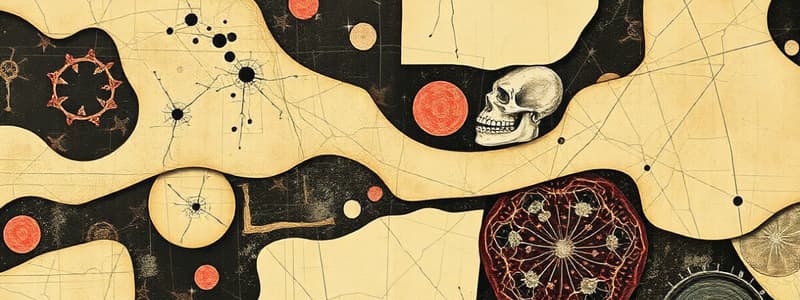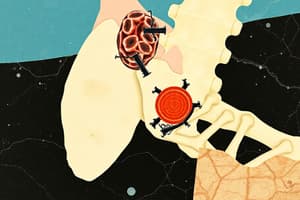Podcast
Questions and Answers
What is the primary protein that gives tendons, ligaments, and cartilages their strength?
What is the primary protein that gives tendons, ligaments, and cartilages their strength?
- Keratin
- Elastin
- Collagen (correct)
- Fibronectin
Which mineral is primarily responsible for the weight-bearing strength of bones?
Which mineral is primarily responsible for the weight-bearing strength of bones?
- Calcium phosphate (correct)
- Sodium chloride
- Potassium sulfate
- Magnesium
Which type of bone is characterized as being longer than they are wide?
Which type of bone is characterized as being longer than they are wide?
- Short bones
- Irregular bones
- Long bones (correct)
- Flat bones
What is the function of proteoglycans in connective tissue?
What is the function of proteoglycans in connective tissue?
Which part of a long bone is described as the central shaft-like structure?
Which part of a long bone is described as the central shaft-like structure?
What shape best describes short bones?
What shape best describes short bones?
Which of the following bones is categorized as a flat bone?
Which of the following bones is categorized as a flat bone?
What is the role of the endosteum in long bones?
What is the role of the endosteum in long bones?
What function does the skeletal system perform in relation to vital organs?
What function does the skeletal system perform in relation to vital organs?
Which type of bone has a complex shape and does not fit into other categories?
Which type of bone has a complex shape and does not fit into other categories?
Flashcards
Collagen
Collagen
A tough, rope-like protein that provides strength to tendons, ligaments, and cartilages. Imagine it as steel bars reinforcing concrete.
Hydroxyapatite
Hydroxyapatite
A mineral component in bone, similar to the concrete in a building, providing compressional strength and weight-bearing capacity. It's primarily composed of calcium phosphate crystals.
Proteoglycans
Proteoglycans
Large molecules composed of polysaccharides attached to core proteins. They act like a sponge, attracting and retaining water.
Long bones
Long bones
Bones that are longer than they are wide, with knobby ends for articulations. They have a hollow middle and are solid at the ends, like a hollow tube with a strong wall.
Signup and view all the flashcards
Articular cartilage
Articular cartilage
The thin layer of hyaline cartilage covering the ends of long bones that helps with smooth movement in joints, like a layer of protective padding.
Signup and view all the flashcards
Periosteum
Periosteum
The dense connective tissue that covers the outside of the diaphysis (shaft) of a long bone protecting and supporting the bone.
Signup and view all the flashcards
Endosteum
Endosteum
A thin epithelial membrane that lines the inside of the medullary cavity (hollow space in the bone) helping with bone growth and repair.
Signup and view all the flashcards
Diaphysis
Diaphysis
The central shaft of a long bone, providing strength and support. Think of it as the main body of the bone.
Signup and view all the flashcards
Epiphysis
Epiphysis
The rounded ends of a long bone, where it connects to other bones forming joints. Think of them as the caps at the end of a long bone.
Signup and view all the flashcards
Medullary cavity
Medullary cavity
The hollow space inside the diaphysis of a long bone that often contains yellow marrow, which stores fat.
Signup and view all the flashcardsStudy Notes
Extracellular Matrix
- Crucial for bone, cartilage, tendons, ligaments structure
- Collagen: Tough, rope-like protein, providing strength (like steel in concrete)
- Mineral component (like concrete): Provides compression strength
- Hydroxyapatite: Primary mineral in bone, calcium phosphate crystals
- Proteoglycans: Large molecules of polysaccharides attached to proteins
- Proteoglycans aggregate, attracting and retaining water
Classification of Bones
- Long Bones: Longer than wide, knobby ends for articulation
- Hollow shafts, solid ends
- Articular cartilage (hyaline) coats ends for joint articulation
- Slightly curved for strength
- Examples: Arms, legs, fingers, toes
- Parts:
- Diaphysis (shaft)
- Epiphysis (ends)
- Medullary cavity (marrow cavity)
- Periosteum (outer connective tissue layer)
- Endosteum (inner epithelial membrane lining the medullary cavity)
- Short Bones: Equal length and width, nearly cube-shaped
- Examples: Ankle and wrist bones
- Flat Bones: Thin, provide protection and muscle attachments
- Examples: Skull, sternum, ribs
- Irregular Bones: Complex shapes
- Examples: Face and vertebral column bones
Functions of the Skeletal System
- Support: Supports and stabilizes soft tissues (muscles, blood vessels, nerves, fat, skin)
- Protection: Protects vital organs (brain, spinal cord, heart, lungs) and other soft tissues
- Movement: Provides attachments for muscles, acting as levers during movement
- Blood Cell Production: Hemopoiesis (making blood cells) occurs in red bone marrow, a connective tissue within bone
- Storage: Stores mineral salts (phosphorus, calcium) and fats
- Yellow bone marrow (adipose cells, triglycerides – fats)
- Red bone marrow (in newborns, all marrow is red; with age, much changes into yellow)
Studying That Suits You
Use AI to generate personalized quizzes and flashcards to suit your learning preferences.




